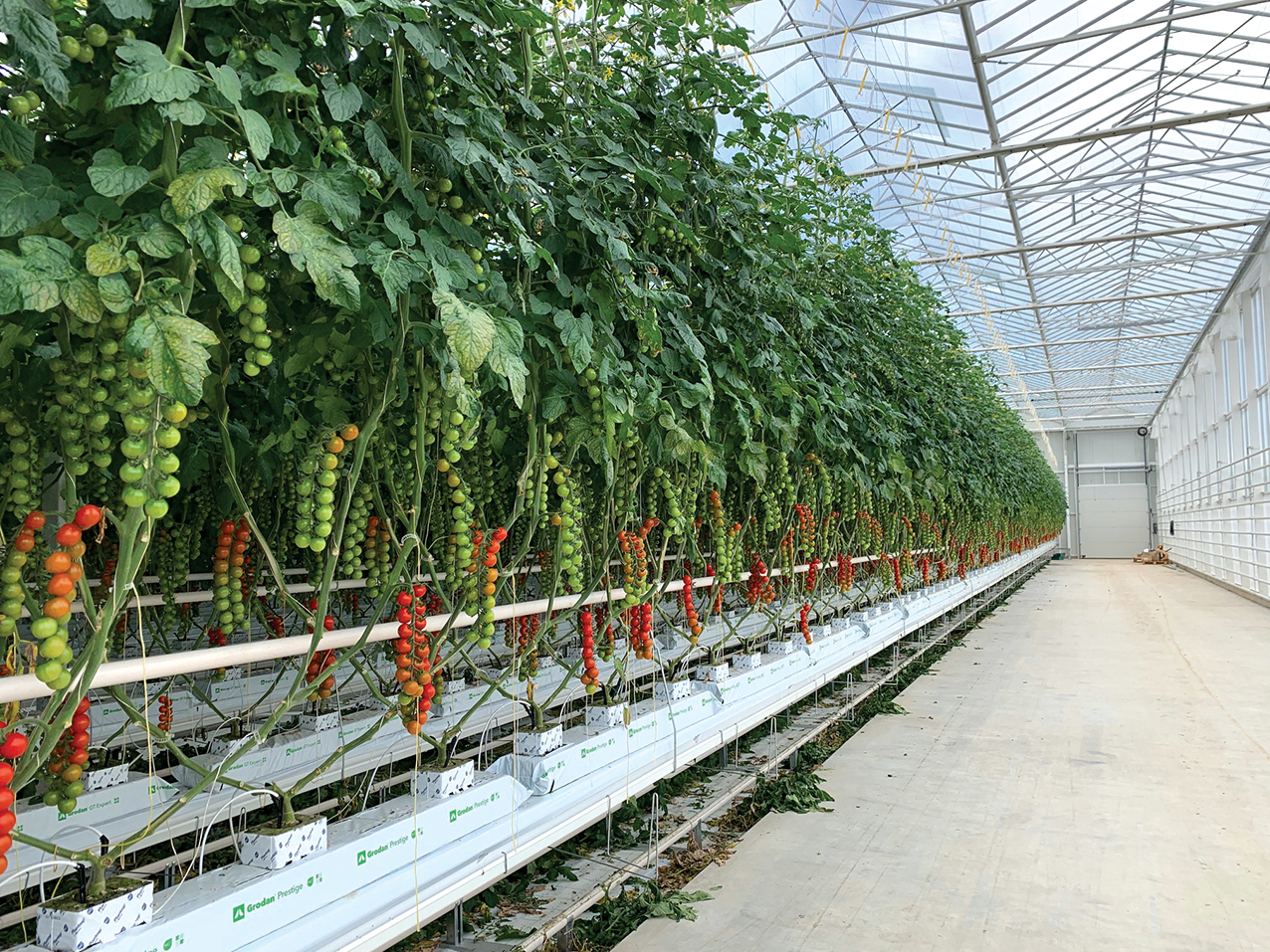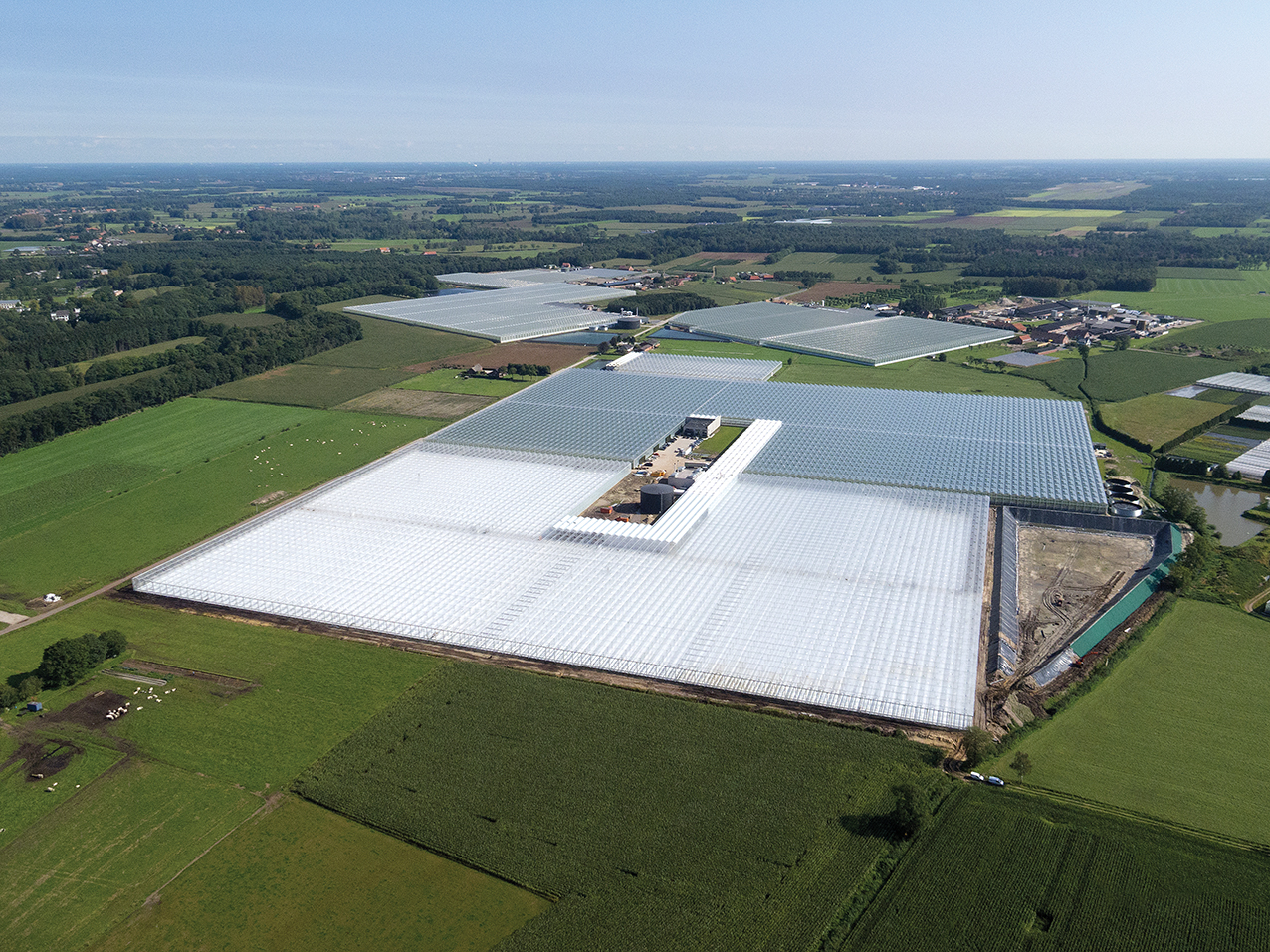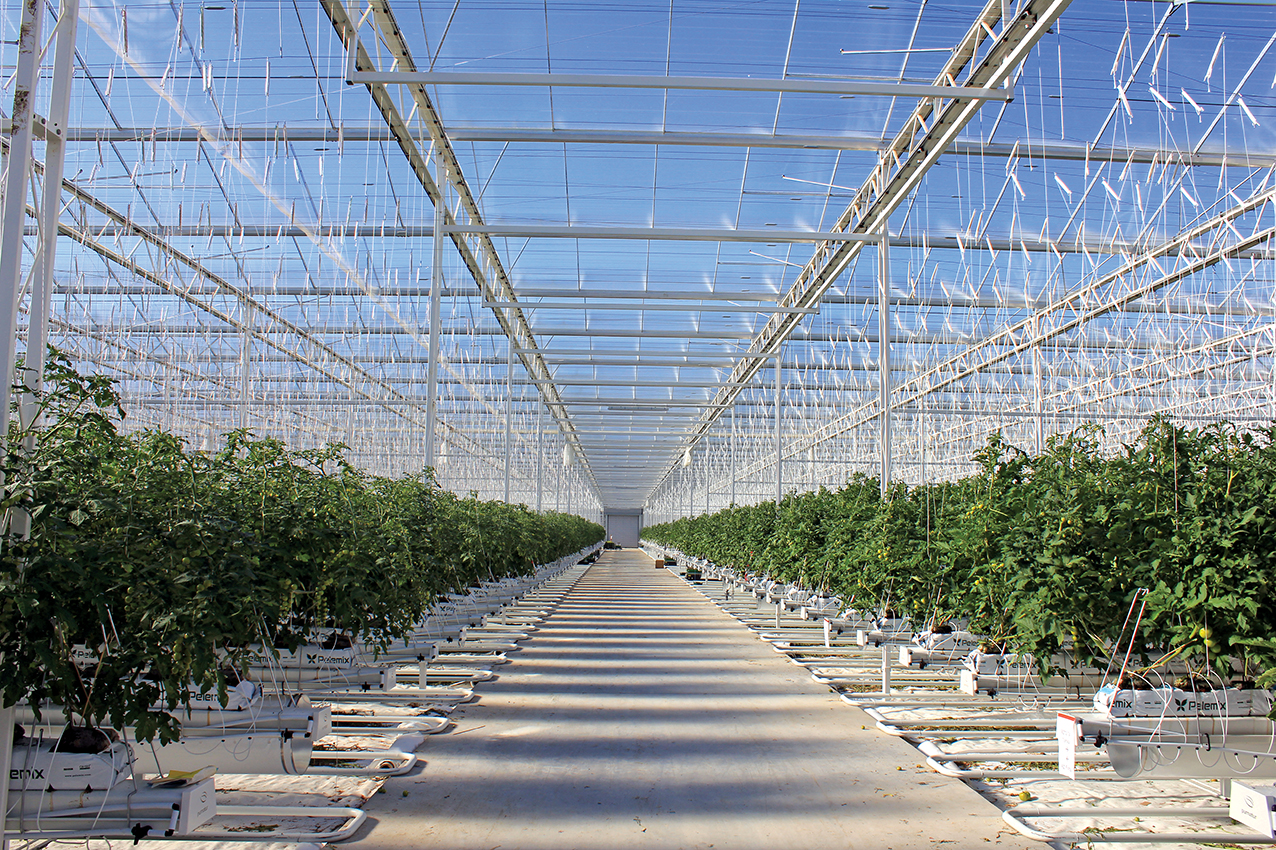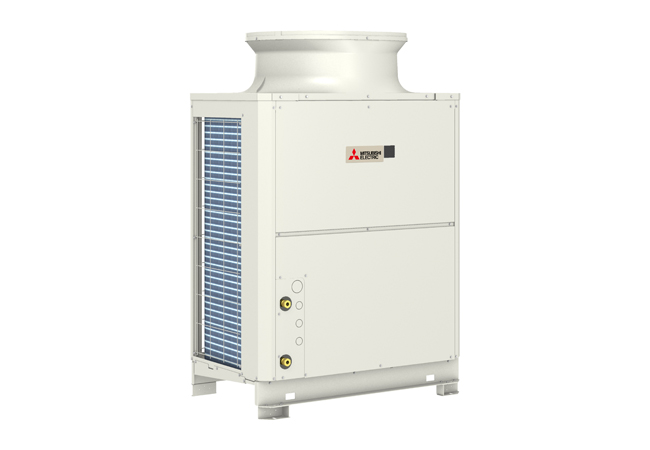
Tomatoes growing in a Dutch greenhouse. Credit: Greencoat
Could two new sustainable giant greenhouses being built in Norfolk and Suffolk be part of the answer to a growing problem? Sustainability and reducing greenhouse gas (GHG) emissions are increasingly important issues for the agricultural sector, which is estimated to account for up to 9% of total GHG emissions produced in the UK.
The National Farmers’ Union (NFU) is targeting net-zero emissions in British farming by 2040, and while most of the sector’s GHGs come from sources such as methane produced by cattle and nitrous oxide released by fertilisers, the food supply chain – from transport and distribution to infrastructure and buildings – has a key role to play.
The recent announcement that two of the largest greenhouses in the UK are to be powered by low carbon sustainable energy sourced from waste heat from water recycling centres is, therefore, a significant development. And, its backers claim, it could offer a model for the decarbonisation of agriculture in this particularly energy-intensive, and conventionally energy-inefficient, part of the sector.
Sustainability
The two innovative greenhouse developments are located at farmland sites near Norwich and Bury St Edmunds, covering 16 and 13 hectares respectively – a larger area than London’s O2 arena – and use more than five times as much glass as The Shard. They are part of a £120m project being developed by Oasthouse Ventures that’s backed by asset management firm Greencoat Capital (the UK’s largest investor in renewables).
The carbon footprint of the food produced there is expected to be 75% lower than equivalent European greenhouses, and Greencoat estimates they will be capable of producing 20 tonnes of tomatoes a day – some 12% of the UK’s needs.
The 7m-high greenhouse structures, which are being built by Dutch glasshouse specialist BOM Group, rely on a hydroponics-based vertical growing system that includes 177km of growing gutters for a range of plants and vegetables. Conventional gas warming will be replaced with heating supplied via closed loop heat pumps that use waste heat from nearby wastewater treatment plants run by Anglian Water.

Greenhouses in The Netherlands. Credit: Greencoat
The Smart Energy Services business unit at Irish utility Electricity Supply Board (ESB) has been selected by Greencoat to design, install and manage the closed loop heat pump system, as well as combined heat and power (CHP) plants at each site.
The CHP units will provide electricity to power the heat pumps and will also transfer supplementary CO2 into the greenhouses to accelerate crop growth, recapturing a high proportion of the carbon created. All of the heat and electricity produced by the CHP units will be used on site, making it one of the most efficient CHP systems in the UK, according to ESB.
The systems being developed by ESB will constitute the highest installed capacity of heat pump technology so far in the UK, capable of generating a combined total of 70MW peak of thermal power. The system will also result in the treated water outflows from the recycling centres being cooled sufficiently before they are released back into the river, benefiting local ecosystems.
Concept
Neil Lawson is ESB’s head of renewable heat development (and a non-executive director of energy consultant Low Carbon Farming). He has been involved in the project since its inception three years ago, when Oasthouse Ventures began looking into large-scale sustainable greenhouse sites.
‘The original concept was for a low carbon centre with ground source, using waste heat from a local water recycling plant without the need for CHP,’ Lawson says. ‘But as we moved along, we discovered how much CO2 the plants required.’
The ground-source heat pumps (GSHPs) deliver the primary heat capacity required for the greenhouses, while the gas-powered CHP will produce the CO2, Lawson says.
‘We realised it was cheaper to use gas-fired CHPs to produce CO2 on site than it was to bring bottled gas in.’ Sized for CO2 production, the capacity of the CHP units are 3 x 1.2MWe for the Norwich site and 2 x 1.2MWe for Bury St Edmunds.
In an environment where maintaining heating levels is critical for crop production, emergency backup is provided in the form of a generator, to provide basic power for the greenhouse and heating system circulation pumps, and gas-fired boilers in case of power failure.
Lawson, who also led the project to install GSHPs to the recent V&A Dundee scheme (see ‘Playing to the gallery’, CIBSE Journal, January 2019), was behind the concept of using waste heat from a water treatment works.
One of the fundamental requirements for the project was, therefore, to find suitable farmland in proximity to such facilities with sufficient outflow capacity. The Norwich and Bury St Edmunds sites met these criteria, and ticked other boxes – such as being situated on flat, non-flood plain land with access to roads and local labour.
On site
Using waste heat from the Anglian Water recycling facilities is a cost-effective option, says Lawson. ‘On the Norwich site, we will have 38MW capacity, while at Bury St Edmunds we have 32MW of ground source. We’re using the outfall from the Anglian Water recycling centres – the clean water discharge that goes to the river. For this capacity of installation, one would usually use a river source.
‘We’re using an ambient loop. The outfall from the sewage treatment works is 3K or 4K higher than the river temperature, and every 1K increase in source temperature is worth about 2.5% efficiency, so our system at these sites is 10% more efficient than if we were using a river source.’

Credit: Greencoat
Lawson says: ‘We use a plate heat exchanger to extract heat from the discharge. At Norwich, this is 1,000L.s-1 and, at Bury St Edmunds, it’s 550L.s-1,
and we’re taking between 3K and 6K out of the water. One of the requirements for Anglian Water’s licence is to ensure that the discharge water mustn’t be too hot going into the river, as it could have detrimental consequences on the local ecosystem. So taking 3K or more from the outfall, we help them to protect the environment.’
Both greenhouse sites are located around 2.4km from their respective water treatment centres. The heat plate exchanger system extracts the heat energy from the outfall, using a water and heat transfer fluid-based system.
A closed circuit then takes this heat transfer fluid directly up to the heat pumps. (The system employs a food-grade fluid anti-freeze mix suitable for food production sites, rather than a traditional medium such as ethanol, to eliminate the risks associated with contamination from potential leaks.)
China's greenhouse cities
Lolli Olafsson is the founder and CEO of Geyser Thermal Energy, a sustainable energy and water treatment solution specialist that has been working on a huge, low carbon greenhouse project in China along with partners Qanbridge and FreshTeq, led by Tjerk Gorter and plant growth and water specialist Arnoud Tieleman.
Plans are under way to construct massive agroparks across three provinces, covering around 100 hectares, with state-of-the-art greenhouses of 40-50 hectares that are designed to reuse 90% of their energy, with no use of pesticides and minimal use of water.
‘We know that the future of food is going to be in sustainable greenhouses that are part of integrated fresh food chains, from seed to eat,’ says Olafsson. ‘The more we can grow products locally, the more we can reduce our carbon emissions.
‘We’ve been working on a new, flexible, next-generation design that will allow crops to be grown anywhere in the world at any time – a breakthrough that will enable year-round production, which at the moment in many climate zones is not feasible. It will be low cost, and our aim is for them to be carbon neutral and use heat easily from any renewable source available.
‘Innovative water treatment systems ensure water can be reused and not wasted. Hydroponic or aeroponic systems can be used, and the water and air treatment systems – which are more effective than UV light – mean the facilities are pesticide and chemical free. Lights above the plants will kill any bacteria or mould that may get in.
‘Waste from the plants, such as old root systems, are reused, so no nitrates are released into the atmosphere; they are used to generate heat and “biochar”, a natural organic product that is used to clean water and air in the treatment system.
‘A new revolution in fresh food is on its way, and it will most likely take place in China .’
‘One of the simplicities of this system is that
we have HDP pipe buried in the ground,’ says Lawson. ‘Because the temperature gradient between the fluid in the pipe and the ground around is so small, there’s very little heat loss into the ground. And, if you don’t need to install insulated pipe, it makes it very cost-effective. What we potentially lose in the winter, we gain in the summer.’
The sites have a thermal store, so on particularly hot days that store can be charged, says Lawson. ‘Roughly calculated, it would take around 3.5 days for the heat pumps flat out to charge that store from cold to hot.’
The conventional method of heating a greenhouse would be using a CHP to power an electrically led system, with a lot of the heat energy being discharged. But the systems used at the two sites are far more energy efficient, explains Lawson: ‘In these systems, we’re supplying just the right amount of heat to meet the demand.
We have multiple heat pump units in cascade – 16 on the Norwich site and 13 on the Bury St Edmunds site, each one around 2.4MW – and each has the ability to modulate, so we only have the required heat produced to meet the demands of the greenhouse.’
This system enables maintenance on heat pump units to be carried out at times of lower demand, so as not to affect capacity. The heat exchangers and system circulation pumps at the water recycling plant outflow are also duty/standby to ensure adequate redundancy in the system.
Off the shelf
While the scale of the East Anglian projects is challenging – the current largest open loop ground source heating system in the UK has a 5.8MW capacity, compared with the 38MW and 32MW closed-loop systems that they will employ – ESB will be relying on tried and trusted technology, says Lawson.
‘It’s based on our own experiences with deploying heat pumps. We’re keeping it simple, we’re buying readily available off-the-shelf products that we’re putting together in a package – there’s nothing particularly bespoke about them.’
Within the greenhouses, the heat emitter system has been designed specifically with heat pump temperatures in mind to maximise efficiency. ‘There are lower temperature heat emitter circuits,’ says Lawson. ‘The lower the flow temperature of the heat pump, the more efficient it is.
It works the same way as the source temperature – a 1K drop in flow temperature equates to a 2.5% increase in efficiency. So we’ve sized all the growing rails to have a 50ºC flow temperature at worst case, and then we weather-compensate it from there.
‘That means the heat pumps are more efficient than stipulating a 75ºC flow temperature and having to select a really high temperature heat pump. It doesn’t really need to be that hot – you can still get the full 38MW into the greenhouse at lower flow temperatures.’
Cost saving
The project will benefit from the UK government’s renewable heat incentive scheme. The projected capex cost per kilowatt of installed capacity of the GSHP system, according to ESB, is £249 per kW peak, with water extraction £100 per kW peak.
And, with a relatively simple system compared with conventional CHP-based greenhouse heating – with fewer moving parts involved – maintenance costs are considerably lower too; ESB estimates the GSHP annual maintenance at £4.50 per kW peak and the CHP maintenance costs at £100 per kW peak.
At current grid carbon levels, ESB Smart Energy Services projects the design of this energy centre will provide 1.2 million tonnes of carbon savings for both sites over the 20-year life of the project, compared with a standard CHP glasshouse. And as grid decarbonisation gathers pace, total carbon savings are expected to grow accordingly.
As well as its capability to meet a large proportion of the UK’s demand for vegetables such as tomatoes, the project will also boost local employment, creating around 360 permanent jobs and bringing a further 120 in high season.
‘These greenhouses tick so many boxes when you’re talking about Brexit and food security, employment and food miles,’ says Lawson. ‘Is this type of solution the future of food production? Absolutely.’


